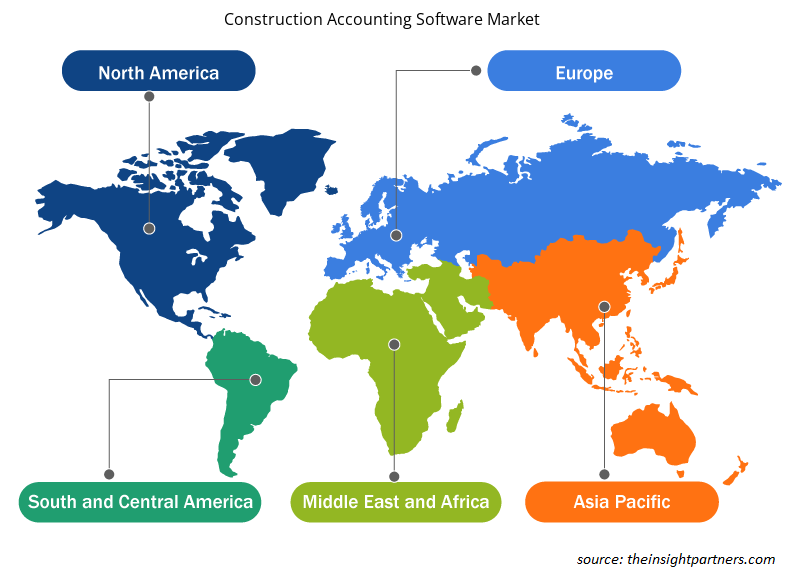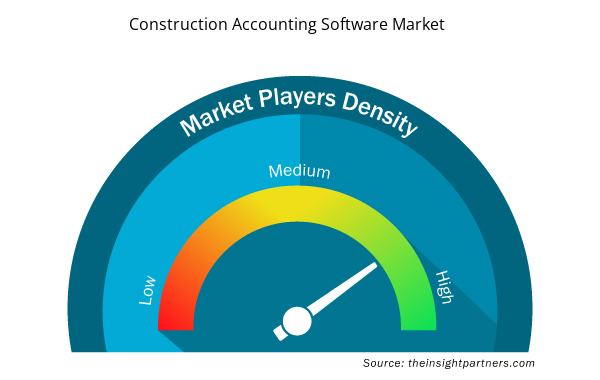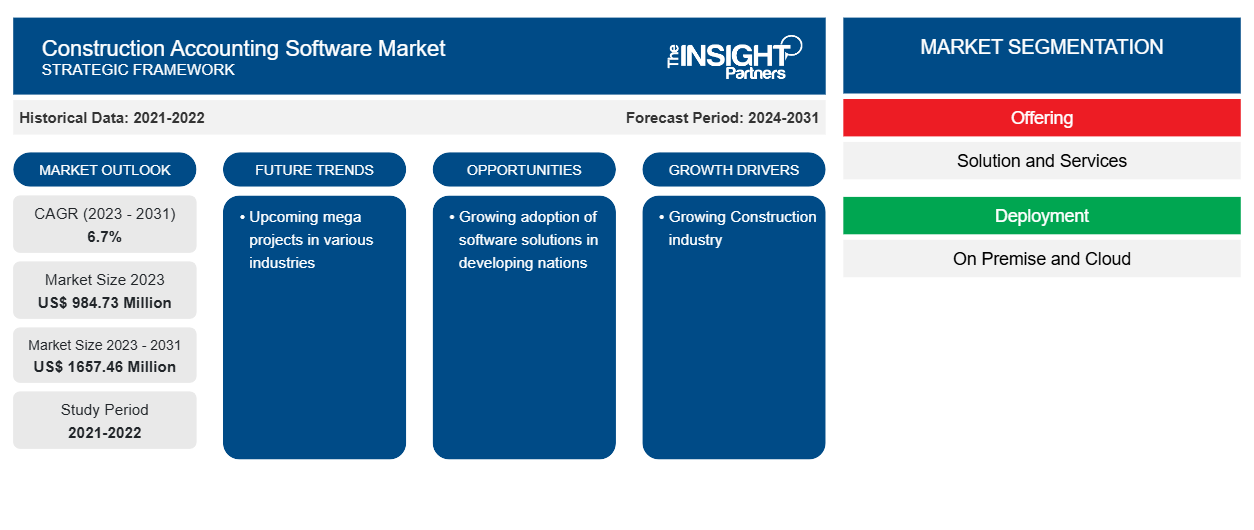Der Markt für Baubuchhaltungssoftware soll von 984,73 Millionen US-Dollar im Jahr 2023 auf 1.657,46 Millionen US-Dollar im Jahr 2031 anwachsen. Der Markt wird zwischen 2023 und 2031 voraussichtlich eine durchschnittliche jährliche Wachstumsrate von 6,7 % verzeichnen. Die zunehmende Digitalisierung in der Baubranche und die wachsende Bauindustrie werden voraussichtlich weiterhin wichtige Trends auf dem Markt bleiben.
Marktanalyse für Buchhaltungssoftware im Baugewerbe
Die steigende Nachfrage aus dem Wohn- und Gewerbesektor treibt die wachsende Baubranche an. Dieser Faktor führt dazu, dass die Finanzverwaltung der Bauunternehmen Baubuchhaltungssoftware einführt. Die Software hilft Bauunternehmen dabei, Geldein- und -ausgänge genau zu verfolgen. Die Software behandelt Aspekte der Baubranche, wie z. B. Auftragskosten und Einbehalte. Solche Funktionen von Baubuchhaltungssoftware führen zu ihrer Einführung.
Marktübersicht für Buchhaltungssoftware im Baugewerbe
Baubuchhaltungssoftware bietet kleinen und mittleren Bauunternehmen sowie großen Bauunternehmen Finanzmanagementtools für Bauprojekte und -aktivitäten. Diese Softwarelösung bietet Funktionen wie Lohn- und Gehaltsabrechnung, Auftragskostenrechnung, Hauptbuchhaltung, Kreditoren- und Debitorenbuchhaltung (AP/AR), Prüfberichte und mehr. Einige Baubuchhaltungslösungen konzentrieren sich auf bestimmte Finanzinformationen für Projekte, während andere Buchhaltungseinblicke für das gesamte Unternehmen bieten.
Passen Sie diesen Bericht Ihren Anforderungen an
Sie erhalten kostenlos individuelle Anpassungen an jedem Bericht, einschließlich Teilen dieses Berichts oder einer Analyse auf Länderebene, eines Excel-Datenpakets sowie tolle Angebote und Rabatte für Start-ups und Universitäten.
- Holen Sie sich die wichtigsten Markttrends aus diesem Bericht.Dieses KOSTENLOSE Beispiel umfasst eine Datenanalyse von Markttrends bis hin zu Schätzungen und Prognosen.
Treiber und Chancen auf dem Markt für Buchhaltungssoftware für das Baugewerbe
Wachsende Bauindustrie
Die Baubranche ist führend bei der Entwicklung und Verbesserung von Infrastrukturen wie Straßen, Eisenbahnen, Flughäfen und Häfen. Diese Infrastrukturinvestitionen verbessern die Konnektivität, den Handel und die wirtschaftliche Entwicklung eines jeden Landes. Daher fördert die wachsende Baubranche die Einführung von Baubuchhaltungssoftware, die für Buchhaltungsanwendungen verwendet wird, darunter Kreditorenbuchhaltung, Debitorenbuchhaltung, Lohnbuchhaltung und Hauptbuchhaltung sowie Module für Auftragskosten, Kostenvoranschläge, Gerätekontrolle, Bestandskontrolle, Einkaufsbestellungen, Arbeitsaufträge und AIA-Abrechnungen.
Zunehmende Nutzung von Softwarelösungen in Entwicklungsländern
Entwicklungsländer wie Indien und China greifen schnell auf die Digitalisierung zurück, was zur Einführung von Softwarelösungen in verschiedenen Branchen, darunter auch der Baubranche, führt. Diese Länder setzen in großem Umfang Baubuchhaltungssoftware ein, um Herausforderungen wie komplexe Tabellenkalkulationen, verlorene Quittungen und endlosen Papierkram zu bewältigen. Die Einführung der Software bietet Bauunternehmen Funktionen für das Finanzmanagement.digitalization, which is leading to the adoption of software solutions in various industries, including the construction industry. These countries are widely adopting construction accounting software to tackle challenges such as complex spreadsheets, lost receipts, and never-ending paperwork. The software adoption provides financial management functionality for construction firms.
Segmentierungsanalyse des Marktberichts zur Baubuchhaltungssoftware
Wichtige Segmente, die zur Ableitung der Marktanalyse für Baubuchhaltungssoftware beigetragen haben, sind Angebot, Bereitstellung und Anwendung.
- Basierend auf dem Angebot ist der Markt für Baubuchhaltungssoftware in Lösungen und Dienstleistungen unterteilt. Das Lösungssegment hat im Jahr 2023 den größten Marktanteil.
- Der Markt ist nach Bereitstellung segmentiert in On-Premise und Cloud . Das Cloud-Segment wird voraussichtlich mit der höchsten durchschnittlichen jährlichen Wachstumsrate wachsen.CAGR.
- Nach Anwendung ist der Markt in kleine und mittlere Bauunternehmen und große Bauunternehmen segmentiert. Das Segment der kleinen und mittleren Bauunternehmen wird voraussichtlich mit der höchsten durchschnittlichen jährlichen Wachstumsrate wachsen.CAGR.
Marktanteilsanalyse für Buchhaltungssoftware im Baugewerbe nach geografischen Gesichtspunkten
Der geografische Umfang des Marktberichts für Baubuchhaltungssoftware ist hauptsächlich in fünf Regionen unterteilt: Nordamerika, Asien-Pazifik, Europa, Naher Osten und Afrika sowie Süd- und Mittelamerika.
Die Region Nordamerika hielt einen bedeutenden Marktanteil. Die wachsende Bauindustrie ist der Hauptfaktor, der den Markt in der Region antreibt. Die Bauindustrie ist einer der Hauptfaktoren für die Wirtschaft der Länder der Region, was zur Einführung von Softwarelösungen zur Vereinfachung der Aufgaben in der Baubuchhaltung geführt hat. Die steigende Zahl an Bauprojekten und der wachsende Wohnsektor treiben das Marktwachstum an.
Regionale Einblicke in den Markt für Buchhaltungssoftware für das Baugewerbe
Die regionalen Trends und Faktoren, die den Markt für Buchhaltungssoftware für das Baugewerbe im Prognosezeitraum beeinflussen, wurden von den Analysten von Insight Partners ausführlich erläutert. In diesem Abschnitt werden auch die Marktsegmente und die Geografie von Buchhaltungssoftware für das Baugewerbe in Nordamerika, Europa, im asiatisch-pazifischen Raum, im Nahen Osten und Afrika sowie in Süd- und Mittelamerika erörtert.

- Erhalten Sie regionale Daten zum Markt für Buchhaltungssoftware für das Baugewerbe
Umfang des Marktberichts für Buchhaltungssoftware im Baugewerbe
| Berichtsattribut | Details |
|---|---|
| Marktgröße im Jahr 2023 | 984,73 Millionen US-Dollar |
| Marktgröße bis 2031 | 1657,46 Millionen US-Dollar |
| Globale CAGR (2023 - 2031) | 6,7 % |
| Historische Daten | 2021-2022 |
| Prognosezeitraum | 2024–2031 |
| Abgedeckte Segmente | Durch das Angebot
|
| Abgedeckte Regionen und Länder | Nordamerika
|
| Marktführer und wichtige Unternehmensprofile |
|
Dichte der Marktteilnehmer für Buchhaltungssoftware für das Baugewerbe: Die Auswirkungen auf die Geschäftsdynamik verstehen
Der Markt für Buchhaltungssoftware für das Baugewerbe wächst rasant. Dies wird durch die steigende Nachfrage der Endnutzer aufgrund von Faktoren wie sich entwickelnden Verbraucherpräferenzen, technologischen Fortschritten und einem größeren Bewusstsein für die Vorteile des Produkts vorangetrieben. Mit der steigenden Nachfrage erweitern Unternehmen ihr Angebot, entwickeln Innovationen, um die Bedürfnisse der Verbraucher zu erfüllen, und nutzen neue Trends, was das Marktwachstum weiter ankurbelt.
Die Marktteilnehmerdichte bezieht sich auf die Verteilung der Firmen oder Unternehmen, die in einem bestimmten Markt oder einer bestimmten Branche tätig sind. Sie gibt an, wie viele Wettbewerber (Marktteilnehmer) in einem bestimmten Marktraum im Verhältnis zu seiner Größe oder seinem gesamten Marktwert präsent sind.
Die wichtigsten Unternehmen auf dem Markt für Buchhaltungssoftware für das Baugewerbe sind:
- Sage Group plc
- Chetu Inc
- Procore Technologies
- Deltek Inc
- Foundation Software, LLC
- Frisches Buch
Haftungsausschluss : Die oben aufgeführten Unternehmen sind nicht in einer bestimmten Reihenfolge aufgeführt.

- Überblick über die wichtigsten Akteure auf dem Markt für Buchhaltungssoftware für das Baugewerbe
Neuigkeiten und aktuelle Entwicklungen zum Markt für Buchhaltungssoftware für das Baugewerbe
Der Markt für Buchhaltungssoftware für das Baugewerbe wird durch die Erhebung qualitativer und quantitativer Daten nach Primär- und Sekundärforschung bewertet, die wichtige Unternehmenspublikationen, Verbandsdaten und Datenbanken umfasst. Nachfolgend sind einige der Entwicklungen auf dem Markt für Buchhaltungssoftware für das Baugewerbe aufgeführt:
- Kojo, die führende Plattform für Material- und Bestandsmanagement in der Baubranche, hat die Einführung von Kojo AP (Kreditorenbuchhaltung) angekündigt. Kojo AP ist eine Reihe von Funktionen, die speziell für Buchhaltungsteams im gewerblichen Bauwesen entwickelt wurden, um den letzten Schritt im Materialmanagement-Workflow abzudecken: Zahlungen. Kojo AP eliminiert viele der manuellen Dateneingabeprozesse für Buchhaltungsteams von Bauunternehmern, erkennt automatisch Fehler auf Rechnungen und ermöglicht es Lieferanten, direkt in einem System bezahlt zu werden. (Quelle: Kojo, Pressemitteilung, Mai 2024)
Marktbericht zu Buchhaltungssoftware für das Baugewerbe – Umfang und Ergebnisse
Der Bericht „Marktgröße und Prognose für Buchhaltungssoftware im Baugewerbe (2021–2031)“ bietet eine detaillierte Analyse des Marktes, die die folgenden Bereiche abdeckt:
- Marktgröße und Prognose für Baubuchhaltungssoftware auf globaler, regionaler und Länderebene für alle wichtigen Marktsegmente, die im Rahmen des Berichts abgedeckt sind
- Markttrends für Baubuchhaltungssoftware sowie Marktdynamik wie Treiber, Einschränkungen und wichtige Chancen
- Detaillierte PEST/Porters Five Forces- und SWOT-Analyse
- Marktanalyse für Baubuchhaltungssoftware mit Blick auf wichtige Markttrends, globale und regionale Rahmenbedingungen, wichtige Akteure, Vorschriften und aktuelle Marktentwicklungen
- Branchenlandschaft und Wettbewerbsanalyse, die die Marktkonzentration, Heatmap-Analyse, prominente Akteure und aktuelle Entwicklungen auf dem Markt für Baubuchhaltungssoftware umfasst
- Detaillierte Firmenprofile
- Historische Analyse (2 Jahre), Basisjahr, Prognose (7 Jahre) mit CAGR
- PEST- und SWOT-Analyse
- Marktgröße Wert/Volumen – Global, Regional, Land
- Branche und Wettbewerbsumfeld
- Excel-Datensatz


- Architecture Software Market
- Flexible Garden Hoses Market
- Digital Pathology Market
- Medical Second Opinion Market
- Enteral Nutrition Market
- Mesotherapy Market
- Dried Blueberry Market
- Health Economics and Outcome Research (HEOR) Services Market
- Data Center Cooling Market
- Medical and Research Grade Collagen Market

Report Coverage
Revenue forecast, Company Analysis, Industry landscape, Growth factors, and Trends

Segment Covered
This text is related
to segments covered.

Regional Scope
North America, Europe, Asia Pacific, Middle East & Africa, South & Central America

Country Scope
This text is related
to country scope.
Häufig gestellte Fragen
The estimated value of the construction accounting software market will be US$ 1657.46 million by 2031.
Sage Group plc; Chetu Inc.; Procore Technologies; Deltek Inc.; Foundation Software, LLC; Fresh book; Intuit Inc.; Buildertrend; Viewpoint Inc.; and Xero Limited are some of the key players operating in the construction accounting software market.
Upcoming mega projects in various industries are considered a key trend in the construction accounting software market.
The growing digitalization in the construction industry and the rising construction industry are the key driving factors impacting the construction accounting software market.
The global construction accounting software market is estimated to register a CAGR of 6.7% during the forecast period 2023–2031.
Trends and growth analysis reports related to Technology, Media and Telecommunications : READ MORE..
The Insight Partners performs research in 4 major stages: Data Collection & Secondary Research, Primary Research, Data Analysis and Data Triangulation & Final Review.
- Data Collection and Secondary Research:
As a market research and consulting firm operating from a decade, we have published and advised several client across the globe. First step for any study will start with an assessment of currently available data and insights from existing reports. Further, historical and current market information is collected from Investor Presentations, Annual Reports, SEC Filings, etc., and other information related to company’s performance and market positioning are gathered from Paid Databases (Factiva, Hoovers, and Reuters) and various other publications available in public domain.
Several associations trade associates, technical forums, institutes, societies and organization are accessed to gain technical as well as market related insights through their publications such as research papers, blogs and press releases related to the studies are referred to get cues about the market. Further, white papers, journals, magazines, and other news articles published in last 3 years are scrutinized and analyzed to understand the current market trends.
- Primary Research:
The primarily interview analysis comprise of data obtained from industry participants interview and answers to survey questions gathered by in-house primary team.
For primary research, interviews are conducted with industry experts/CEOs/Marketing Managers/VPs/Subject Matter Experts from both demand and supply side to get a 360-degree view of the market. The primary team conducts several interviews based on the complexity of the markets to understand the various market trends and dynamics which makes research more credible and precise.
A typical research interview fulfils the following functions:
- Provides first-hand information on the market size, market trends, growth trends, competitive landscape, and outlook
- Validates and strengthens in-house secondary research findings
- Develops the analysis team’s expertise and market understanding
Primary research involves email interactions and telephone interviews for each market, category, segment, and sub-segment across geographies. The participants who typically take part in such a process include, but are not limited to:
- Industry participants: VPs, business development managers, market intelligence managers and national sales managers
- Outside experts: Valuation experts, research analysts and key opinion leaders specializing in the electronics and semiconductor industry.
Below is the breakup of our primary respondents by company, designation, and region:

Once we receive the confirmation from primary research sources or primary respondents, we finalize the base year market estimation and forecast the data as per the macroeconomic and microeconomic factors assessed during data collection.
- Data Analysis:
Once data is validated through both secondary as well as primary respondents, we finalize the market estimations by hypothesis formulation and factor analysis at regional and country level.
- Macro-Economic Factor Analysis:
We analyse macroeconomic indicators such the gross domestic product (GDP), increase in the demand for goods and services across industries, technological advancement, regional economic growth, governmental policies, the influence of COVID-19, PEST analysis, and other aspects. This analysis aids in setting benchmarks for various nations/regions and approximating market splits. Additionally, the general trend of the aforementioned components aid in determining the market's development possibilities.
- Country Level Data:
Various factors that are especially aligned to the country are taken into account to determine the market size for a certain area and country, including the presence of vendors, such as headquarters and offices, the country's GDP, demand patterns, and industry growth. To comprehend the market dynamics for the nation, a number of growth variables, inhibitors, application areas, and current market trends are researched. The aforementioned elements aid in determining the country's overall market's growth potential.
- Company Profile:
The “Table of Contents” is formulated by listing and analyzing more than 25 - 30 companies operating in the market ecosystem across geographies. However, we profile only 10 companies as a standard practice in our syndicate reports. These 10 companies comprise leading, emerging, and regional players. Nonetheless, our analysis is not restricted to the 10 listed companies, we also analyze other companies present in the market to develop a holistic view and understand the prevailing trends. The “Company Profiles” section in the report covers key facts, business description, products & services, financial information, SWOT analysis, and key developments. The financial information presented is extracted from the annual reports and official documents of the publicly listed companies. Upon collecting the information for the sections of respective companies, we verify them via various primary sources and then compile the data in respective company profiles. The company level information helps us in deriving the base number as well as in forecasting the market size.
- Developing Base Number:
Aggregation of sales statistics (2020-2022) and macro-economic factor, and other secondary and primary research insights are utilized to arrive at base number and related market shares for 2022. The data gaps are identified in this step and relevant market data is analyzed, collected from paid primary interviews or databases. On finalizing the base year market size, forecasts are developed on the basis of macro-economic, industry and market growth factors and company level analysis.
- Data Triangulation and Final Review:
The market findings and base year market size calculations are validated from supply as well as demand side. Demand side validations are based on macro-economic factor analysis and benchmarks for respective regions and countries. In case of supply side validations, revenues of major companies are estimated (in case not available) based on industry benchmark, approximate number of employees, product portfolio, and primary interviews revenues are gathered. Further revenue from target product/service segment is assessed to avoid overshooting of market statistics. In case of heavy deviations between supply and demand side values, all thes steps are repeated to achieve synchronization.
We follow an iterative model, wherein we share our research findings with Subject Matter Experts (SME’s) and Key Opinion Leaders (KOLs) until consensus view of the market is not formulated – this model negates any drastic deviation in the opinions of experts. Only validated and universally acceptable research findings are quoted in our reports.
We have important check points that we use to validate our research findings – which we call – data triangulation, where we validate the information, we generate from secondary sources with primary interviews and then we re-validate with our internal data bases and Subject matter experts. This comprehensive model enables us to deliver high quality, reliable data in shortest possible time.


 Holen Sie sich ein kostenloses Muster für diesen Bericht
Holen Sie sich ein kostenloses Muster für diesen Bericht